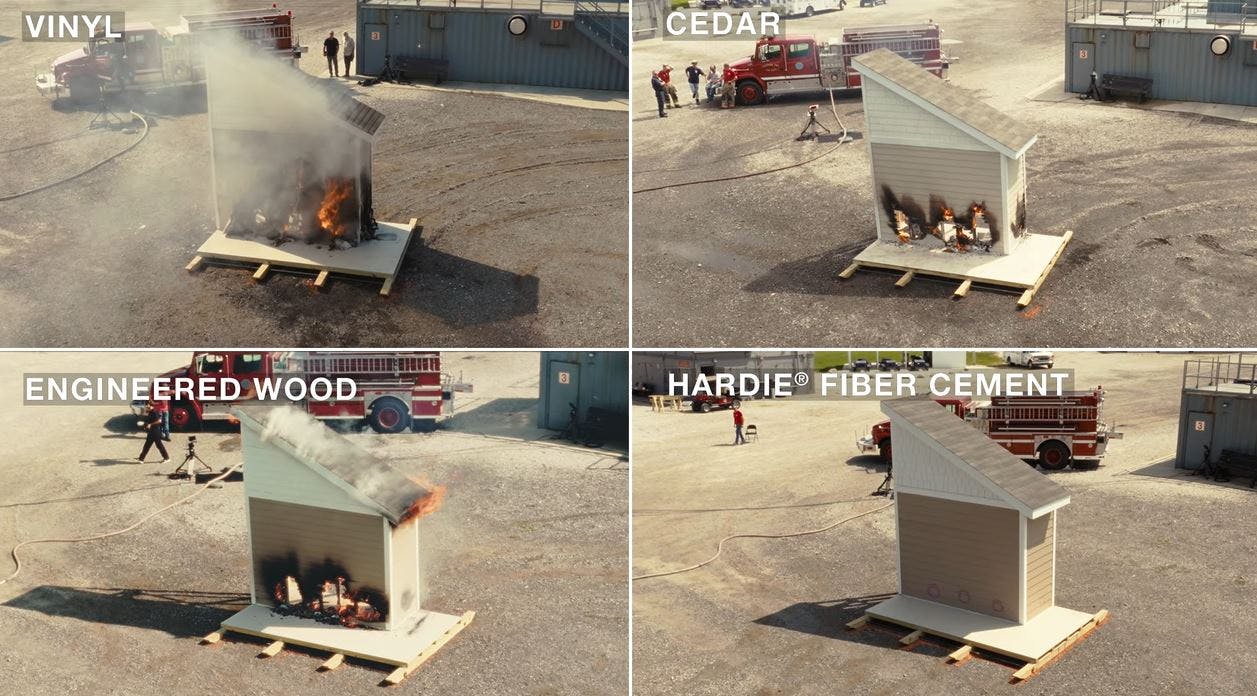Fire resistant siding offers protection for your home

Fire can quickly become deadly. In just a few minutes, a small flame can engulf your home and endanger the lives of your family. All it takes is a mistake in the kitchen or a mishap with an electrical device for your home to catch fire. Even if you take every precaution to avoid a fire inside your home, wildfires are a growing risk. As climate change leads to warmer and drier conditions, wildfire seasons are becoming longer and wildfires are becoming more extreme, according to research from the National Oceanic and Atmospheric Association.
In the past few years, wildfires have behaved in unprecedented ways, throwing embers across mountain divides and inflammable terrain. Globally, forest fires have burned through nearly double the tree cover when compared to two decades ago. Areas where wildfires were once uncommon are now at risk. 80 million properties face a significant threat of wildfire exposure, with one in six Americans housed in a risky area.
Whether or not you live in an area that is prone to wildfires, it’s important to consider the risk of fire and take measures to protect your home and family. Working fire alarms are of the utmost importance to your family’s safety, but they may not protect your home from fires that originate outside. It’s also important to consider fire-resistant siding and soffit materials that can help defend against external flame spread, especially if you’re planning a re-side project.
The risk of combustible siding
Some siding materials are particularly vulnerable to fire. For example, wood siding fuels a fire, and vinyl siding melts when exposed to a flame, releasing toxic gasses and exposing other wood materials to flame. According to the Building America Solution Center, the following materials have low or medium resistance to fire:
- Solid wood siding
- Wood panel siding
- Wood-plastic composite siding
- Vinyl siding or uPVC
In contrast, the following siding materials are rated for high fire resistance.
- Fiber cement siding
- Metal siding
- Brick or stone siding
- Stucco
Of these siding options, fiber cement siding is generally the most affordable. It also comes with a broader range of designs than other fire-resistant siding materials, and can even be combined with materials, like brick or stone, for an appealing design that can stand up to a fire.
Further, the Insurance Institute for Business and Home Safety (IBHS) recommends enclosing open roof eaves with noncombustible materials, such as Hardie® Soffit panels, adding strip vents near the overhang edge and installing 1/8 -inch mesh over vent openings as one of the most critical upgrades needed to reduce the risk of flying embers entering the attic space.
Building a wildfire-resilient house
While no house can be completely fireproof, noncombustible Hardie® siding provides protection superior to vinyl or wood-based siding. Homes sided in Hardie® siding have remained standing after wildfires turned neighboring homes to ash. That’s because Hardie® siding will not ignite when exposed to a flame, nor will it contribute fuel to a fire. It offers the kind of durability you need to see to believe, and it’s captured in our fire demonstration video.
This demonstration shows how a structure sided in Hardie® siding remains intact, while structures built with vinyl, engineered wood, and cedar siding eventually succumb to the flames. The contrast is astonishing, and the noncombustible properties of Hardie® fiber cement are one reason why fire departments nationwide recognize Hardie® siding*. It’s a product that provides superior overall durability to help protect homes.
Since Hardie® siding and soffit panels are noncombustible, they will give you added peace of mind, whether you live in a wildfire-prone area or are at risk for common household fires from outdoor grills and bonfires. Hardie® products have a Class A fire rating when tested in accordance with ASTM E84, with a flame spread index of 0. And they’re eligible to be used in certain 1-hour fire rated wall assemblies which may be required under local building codes.
Choosing noncombustible siding and soffit panels give you one less variable to worry about when establishing a defensible barrier of noncombustible materials around your home. While it’s important to limit vegetation, wood mulch and combustible structures near your home, you can rest easy knowing your siding won’t add fuel to the flames.
Your dream home, fortified
Hardie® siding may be able to withstand a fire, but what about other weather events? The product has your back there, too. Hardie® products are specifically engineered to resist damage from moisture and rot, whether your home is hit with rain or snow. They also offer little appeal to pests and won’t be eaten by termites, unlike wood siding, which is susceptible to damage from critters.
What’s more, the products are available in ColorPlus® Technology finishes which come with paint baked on at the factory. This finishing technique creates a stronger bond, with the paint resisting chipping, peeling and cracking. ColorPlus® Technology finished products resist fading from UV-rays, unlike vinyl siding.
While durability may be your primary concern as a homeowner, aesthetic appeal merits consideration as well. But Hardie® siding is far more than utilitarian — it’s also versatile enough to achieve the look of multiple siding styles, from board-and-batten to stucco-like finishes — and in gorgeous colors to boot. Download our inspiration guide to see what’s possible, or request a sample to experience the look and feel up close. And if you’re ready to install a product with superior fire resistance, request a quote.
To learn more about protecting your home from natural hazards, visit ibhs.org, fire.ca.gov/prepare, CalFire, or download the “Designing for Natural Hazards Series” publication from huduser.gov."
*Hardie® siding complies with ASTM E136 as a noncombustible cladding and is recognized by fire departments across the U.S. including Marietta, GA, Flagstaff, AZ and Orange County, CA. Fiber cement fire resistance does not extend to applied paints or coatings, which may be damaged or char when exposed to flames.